55TH ANNUAL CONFERENCE, Las Vegas, USA, 14-18 March 2016WP No. 166Space WeatherPresented by TOC |
Summary
This working paper describes the basics of space weather and the negative effect it can have on aviation. In particular, space weather can affect satellite-based navigation and communication systems and present a health risk to aircrew and passengers. In addition, the difficulty of forecasting the occurrence and severity of space weather events accurately and the dissemination of that information present additional challenges that need to be addressed in order to prevent the disruption severe space weather can cause to aviation.
Introduction
1.1 The implementation of the Performance Based Navigation (PBN) concept is a key enabler for the increase in capacity, the improvement in efficiency and the reduction in environmental impact required to facilitate the continued and sustainable growth of aviation. In PBN, aircraft are less dependent on traditional ground-based navigation systems in favour of airborne technologies based on Global Navigation Satellite Systems (GNSSs).
1.2 GNSS is one example of a technology that can be susceptible to failure or unreliable performance due to space weather. Although physicists describe space weather as the branch of space physics dealing with the changing environmental conditions within the Solar System [1], in this paper, space weather refers, in general terms, to the processes that originate in the Sun and other stars, which affect the environmental conditions of the volume of space that surrounds the Earth, i.e. the geospace [2].
1.3 In the context of aviation, space weather also has the potential to affect radio communications, the health of flight crews and passengers and the electrical and electronic aircraft systems. That effect is more noticeable at high latitudes, affecting polar flight routes which, on the other hand, are increasingly popular due to their associated distance and fuel savings.
1.4 This paper is divided in two main parts. The first part looks at the basic concepts of space weather, its components and their effects on the geospace. The second part delves into the effects space weather has on aviation and how space weather information relevant to aviation is gathered and disseminated.
Discussion
Space Weather
2.1 Extending the definition given in 1.2, space weather refers to “the conditions on the Sun and in the solar wind, magnetosphere, ionosphere and thermosphere that can influence the performance and reliability of space-borne and ground-based technological systems and can endanger human life or health” [3]. The concept is quite different from the commonly used term, weather, which refers to the state of the lowest layer of the atmosphere, the troposphere, with respect to different conditions such as wind, rain or temperature. As such, before we can look into the details of space weather to better understand its nature, it is necessary to describe some of the terms in its definition.
2.2 Figure 1 shows the different layers and regions of the Earth’s atmosphere based on temperature (orange and red line), chemical composition (green line) and electrical properties (white line) [4]. The relevant layers, from a space weather perspective, are the thermosphere and the ionosphere. The thermosphere is one of the layers of the upper atmosphere, together with the exosphere. In the thermosphere, its oxygen molecules absorb the energy solar radiation, raising the temperature of this layer well above that on the surface of the Earth. The ionosphere comprises the upper part of the mesosphere, the thermosphere and the exosphere. It is an electrified region in the upper atmosphere where large concentrations of ions, i.e. atoms with a positive or negative charge, and electrons, i.e. negative subatomic particles, exist.
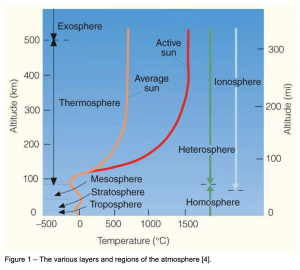
2.3 The other concept that needs to be described before looking at characteristics of space weather is that of the magnetosphere. The Earth’s magnetosphere is the region of space where the dominant magnetic field is the magnetic field of the Earth [5]. The magnetosphere is formed by the interaction of the solar wind, described later in the paper, with the Earth’s magnetic field. Figure 2 shows the shape of the magnetosphere, where it can be seen how the pressure of the solar wind compresses the magnetosphere on the day-side of the Earth and stretches it into a tail on the night-side.
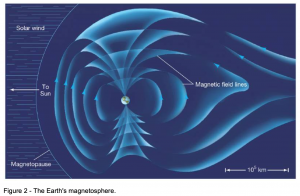
2.4 The magnetosphere, ionosphere and thermosphere are all affected by the Sun’s emissions, which are the primary source of space weather. Some of those emissions are continuous in nature, like the solar wind, which is the continuous flow away from the Sun of charged particles and magnetic field. But there are other emissions, eruptive in nature, which disrupt the solar wind and generate what can be considered as severe space weather. The two major types of eruptive emissions or solar eruptions are [5]:
a) Solar flares: they are huge explosions on the Sun. A flare appears as a sudden, intense brightening region on the Sun, typically lasting several minutes to hours. Their emissions travel at the speed of light, taking about 8 minutes to reach the Earth.
b) Coronal Mass Ejections (CMEs): they are explosive outbursts of magnetic field and plasma from the Sun’s outer atmosphere, the corona. CMEs are not particularly bright and they may take hours to fully erupt from the Sun. They travel at hundreds of kilometres per second and typically take 1 to 4 days to reach the Earth. During periods of high solar activity, CMEs can occur 2-4 times a day and they pose an elevated risk to aviation and aerospace ventures.
2.5 The geophysical consequences of the above eruptive emissions are [2]:
a) Radio blackouts: these blackouts affect the HF band (3-30 MHz), although the detrimental effects may spill over to the VHF band (30-300 MHz). They are a consequence of enhanced electron densities caused by the emissions from the solar flares, which ionise the day-side of the Earth. Their duration is similar to that of the flares that generated them.
b) Solar radiation storms: they occur when a large magnetic eruption, which often generates a CME and an associated solar flare, accelerates charged particles to a very high velocity (up to 1/3 of the speed of light). Depending on the acceleration and propagation of those particles in the geospace, solar radiation storms can last from a few hours to a week. The polar regions on the Earth are the most affected by solar radiation storms [2].
c) Geomagnetic storms: they are strong disturbances to the Earth’s magnetic field embedded in the solar wind. CMEs are often the cause of those disturbances, and the duration of geomagnetic storms is normally in the order of days, but no more than a week.
d) Ionospheric storms: the same disturbances that cause geomagnetic storms affect also the ionosphere, resulting in ionospheric storms. The duration of a ionospheric storm is very similar to that of the associated geomagnetic storm.
2.6 The Sun is a dynamic star and, as such, the levels of continuous and eruptive emissions described above vary with time. That change in the Sun’s activity, known as the solar cycle and caused by the Sun’s magnetic field, has an 11-year period and has been observed for hundreds of years. During each cycle, the Sun goes through a period of high solar activity, i.e. solar maximum, and a period of low solar activity, i.e. solar minimum [5].
2.7 The solar cycle is closely related to the number of sunspots on the surface of the Sun. Sunspots are dark, cooler areas on the solar surface that contain strong, constantly shifting magnetic fields [4]. Sunspots form over periods that can last from days to weeks and they can persist for weeks and even months before erupting or dissipating. Solar maximum occurs when the number of sunspots is most numerous, while solar minimum occurs when the number of sunspots is lowest.
2.8 Therefore, counting the number of sunspots on the surface of the Sun is a relatively simple method of identifying whether the Sun is in a period of high or low solar activity. When the number of sunspots is high, the Sun is in a period where the solar wind is stronger and the number of solar flares and CMEs is relatively high. The opposite occurs when the number of sunspots is low. Extensive recording of the number of sunspots started in 1755 and 24 solar cycles have been identified since. Figure 3 shows the solar cycles through the almost periodic variation in the number of sunspots on the Sun. We are currently in of solar cycle 24, which is believed to have had the peak in the number of sunspots in 2014 [5].
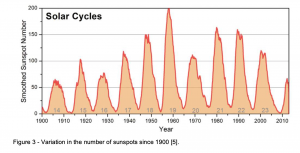
2.9 Finally, It should be noted that there is another type of radiation, not from the Sun, that can have an effect on space weather: Galactic Cosmic Rays (GCR) [2]. GCR are high energy radiation comprised of charged particles generated outside the solar system. They are normally formed by explosive events such as supernovae. GCR are relatively constant in energy and composition, varying slowly with time. However, due to the solar cycle, during solar maximum, GCR are inhibited and only a small fraction reach the geospace, the opposite happens during solar minimum.
Effects of Space Weather on Aviation
2.10 The effects of severe space weather on aviation can be varied in nature and severity and affect both systems, both on the aircraft and on the ground, and people [6].
Communication
2.11 Reliable communications are a fundamental component of aviation. In particular, HF radio waves are used in aviation for long distance communications, where there is no clear line of sight between transmitter and receiver. The reflection of those radio waves off the ionosphere results in the transmission of information over longer distances compared to radio waves which propagate exclusively by line of sight, like those in the VHF or UHF band. The main example of HF communications in aviation is their use in trans-oceanic flights.
2.12 Space weather can negatively affect HF communications by perturbing the ionosphere through radio blackouts, consequence of solar flares. The ionisation of the day-side of the ionosphere prevents the reflection of radio waves off the ionosphere, blocking or significantly degrading HF communications. Depending on the intensity of the solar flare, the radio blackout can completely affect HF communications on the day-side of the Earth for a number of hours [5]. On the other hand, the night-side of the Earth remains unaffected.
2.13 Solar radiation storms can also affect HF communications in the polar regions of the Earth, creating a similar type of radio blackout to the one generated by solar flares. This is especially significant, given the increase in the use of polar routes by commercial aviation in recent years [7]. The effect of space weather on polar routes was particularly significant during the intense space weather storms in October-November 2003 [8].
2.14 Finally, space weather can also affect satellite communications using the UHF band [5]. UHF radio waves are transmitted by line of sight to and from a satellite but those waves are affected by the propagation path they encounter, which can include a highly ionised ionosphere. That results in the distortion and attenuation of those radio waves, a process called scintillation, degrading satellite communications to a lesser or greater extent depending on the intensity of the radio blackout.
Navigation
2.15 In recent years, there has been an increased reliance on GNSS as the main source for navigation as opposed to ground-based navigation aids. GNSS-based navigation is a key element of the ICAO PBN concept, which will pave the way for future ATM systems [9]. However, GNSS systems are adversely affected by space weather in a number of ways.
2.16 Space weather can cause a positioning error during navigation. GNSS systems use a model of the Earth’s ionosphere to calculate its effect on the accuracy of the position information [2]. In calm conditions, that correction method can provide position information accurate to a few centimetres when using dual-frequency GNSS receivers [5]. However, when the ionosphere is disturbed by space weather, the model of the ionosphere no longer represents the effect the ionosphere has had on the radio waves so the GNSS receiver cannot calculate its position accurately. This is particularly critical since the receiver is still locked onto a number of satellites and registers high confidence in the positioning solution, even though the position can be wrong by tens of metres. Again, this effect was particularly noticeable during the intense space weather storms in October-November 2003 [8].
2.17 Another effect of space weather in GNSS systems is the loss of lock, which happens when GNSS receivers can no longer track the signals from the satellites. This loss of lock occurs when strong scintillations are present in the ionosphere, which are more likely in periods of high disturbance [2]. Although that effect can occur at any latitude, it is more common in the polar and equatorial regions.
2.18 The last effect of space weather on GNSS systems is the radio emissions at GNSS frequencies caused by solar flares. Given the relatively low power of the GNSS signal, a strong solar radio burst, with enough energy and the appropriate polarisation, could blackout GNSS systems on the sun-side of the Earth for minutes [7].
Avionics
2.19 In addition to the radio and navigation systems described above, space weather, in particular solar radiation storms, can also affect other electronic equipment, also called avionics, installed in an aircraft [10]. Solar energetic particles indirectly generate charge in semiconductor materials, causing the electronic equipment on board aircraft to malfunction, which is a specific type of Single Event Effects (SEE) [11].
2.20 In its simplest form, the malfunction is caused by Single Event Upsets (SEUs), where the charge from the solar particles corrupts one bit of information in the electronic device. Nowadays, electronic equipment incorporates error detection and correction methods to solve that problem. However, during extreme space weather, the generated charge can be sufficiently large to create Multiple Bit Upsets (MBUs) that exceed the error detection and correction capabilities of the device. This effect is expected to increase as electronic devices are more power efficient and their components become smaller, requiring a comparatively smaller charge to cause SEUs or MBUs [10].
2.21 From a practical point of view, SEE may affect systems and functions like fly-by-wire technology, autopilot or flight warnings [11].
Radiation
2.22 The interaction of solar particles and GCR with the particles in the upper atmosphere indirectly creates a flux of ionising radiation that penetrates the atmosphere, although only a small percentage reaches the surface of the Earth. At typical aircraft cruising levels, the flux of ionising radiation is approximately 300 times higher than at sea level [10]. Consequently, aircraft crew and passengers are subject to a higher level of radiation than the rest of the population at any one time.
2.23 It is widely accepted that ionising radiation has negative effects on human health. One way of evaluating the long term effects of radiation is to measure the effective radiation dose, which is the energy deposited in human tissue weighted by the radiosensitivity of each organ and the type and energy of the radiation. The probability of cancer and hereditary effects is believed to correlate linearly with that effective dose [10].
2.24 The effective radiation dose increases with altitude and the effect is more noticeable at high polar latitudes, where the Earth’s magnetic field does not provide the same shielding as at the Equator. As an example, at 20,000 feet, the average effective dose rate at the 70th parallel north is approximately double the one at the Equator, whereas at 40,000 feet, the average effective dose rate at the 70th parallel north is approximately four times the one at the Equator [12].
2.25 In the event of severe space weather, the level of ionising radiation increases greatly at typical aircraft cruising levels. The effective dose rates have been observed to increase by orders of magnitude when the particular space weather event takes place [13], with the consequent considerably greater long-term risk for the health of aircraft crew and passengers.
2.26 Figure 4 shows the different effects of space weather on aviation described in this paper. It also shows other effects of space weather on the Earth and the geospace, which are beyond the scope of this paper.

2.27 Therefore, from an air traffic controller’s point of view, space weather events can severely affect the main components of the ATM infrastructure, namely communication, navigation and surveillance systems. However, other aspects of the ATM system can also be affected. For example, the unavailability of specific routes due to severe space weather might result in the reorganisation of air traffic flows and the consequent change in staffing requirements. Furthermore, equipment outage or malfunction might result in some procedures or methods of operation not being available, changing how air traffic controllers carry out their duties. Overall, severe space weather has the potential to cause ATM to enter a degraded mode of operation and, as such, appropriate contingency procedures are necessary to maintain the required level of service in those situations.
2.28 As a concluding remark, how often can the most severe events described above take place? Figure 5 shows the probability of space weather events as a function of their impact on the Earth and on aviation. It can be observed how the most extreme space weather events have a very low probability of occurrence, taking place only every few solar cycles. However, events which can have an operational effect on aviation can take place every solar cycle [14].
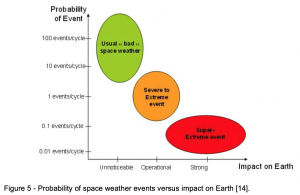
2.29 In September 1859, one of the largest geomagnetic storms on record, known as the Carrington event, took place during solar cycle 10. It was generated by a major CME which hit the Earth’s magnetosphere after having travelled the distance between the sun and the Earth in less than 20 hours as opposed to the more typical few days [10]. The geomagnetic storm caused the failure of telegraph and telephone systems over North America and Europe and aurora lights were seen all around the world. Although it caused considerable disruption, its effects would have been much more serious nowadays. In fact, the solar storm of 2012 was of similar magnitude to that of the Carrington event, but the former did not hit the Earth when passing through the Earth’s orbit [10].
Provision of Space Weather Information
2.30 Given the negative effects space weather can have on aviation, airline operators, flight crew and air navigation service providers require accurate and timely information on space weather in order to mitigate its impact on aviation operations. That information must contain both observations and forecasts of space weather likely to affect the earth’s surface or atmosphere so that effective decision making by all stakeholders can take place to ensure the safety and efficiency of air travel.
2.31 At the 2002 Meteorology (MET) Divisional Meeting within ICAO, a recommendation was made to assess, in consultation with the World Meteorological Organisation (WMO), the need for providing information on solar radiation storms and other bio-hazards [15]. As a result, the International Airways Volcano Watch Operations Group (IAVWOPSG) has been working since 2004 to establish operational requirements for the provision of space weather services for international air navigation. The WMO, as member of IAVWOPSG, has been actively involved in the process through its Inter-Programme Coordination Team on Space Weather (ICTSW). IAVWOPSG was formally disbanded in June 2015 and its remaining tasks were included in the work programme of the Meteorology Panel (METP) within ICAO. Before its disbandment, IAVWOPSG produced a draft document detailing the concept of operations for the provision of space weather information in support of international air navigation [7]. The rest of this section will highlight the most relevant aspects of such document.
2.32 The main objective of a space weather service is to provide information to the global aviation community relating to space weather conditions that may adversely affect communications, navigation systems and the health of crew and passengers [7]. That information can be of the following types:
a) Observations from space-based and/or ground-based monitoring systems to detect and measure local disturbance caused by solar eruptive events.
b) Analysis of those observations to assess the characteristics of the space weather environment at a specified time.
c) Forecast information predicting the evolution or impacts of solar activity.
d) Climatology information detailing the state of the space weather information over a period of time.
2.33 Currently, the provision of hazardous weather information for one Flight Information Region (FIR) is undertaken by its corresponding Meteorological Watch Office (MWO). However, the large scale effects of space weather, often affecting a number of FIRs, makes the MWO approach inefficient, information would be duplicated in the best case and contradictory in the worst case. The recommendation in [7] is to consolidate the responsibilities of space weather services into a number of global centres.
2.34 The above-mentioned global centres would be supported by the International Space Environment Service (ISES) and its 16 Regional Warning Centres (RWCs) [16]. ISES is a scientific non-governmental organisation which provides real-time forecasting and monitoring of space weather under the direction of the Space Weather Prediction Centre (SWPC) in Boulder (USA) [5]. ISES also facilitates international communication and service coordination regarding space weather, especially during periods of extreme space weather. Figure 6 shows the location of the 16 RWCs.
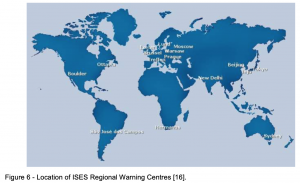
2.35 The current provision of space weather information with regards to the observations, analysis and forecasts mentioned in 2.30 is as follows [7]:
a) Observations: the WMO defines the list of observation variables and their requirements for the provision of space weather information. Different observations are used to measure different space weather events like CMEs (observing, for example, solar wind density), solar flares (X-ray fluxes) or radiation storms (proton fluxes). In addition, those observations can be linked to specific impacts of space weather events on aviation, i.e. radiation, navigation or HF communications.
b) Analysis: the analysis of space weather is used to provide space weather alerts to aviation and other users. In the case of aviation, different analyses are used to provide alerts about radiation (using proton flux data), navigation (total electron maps) or HF communications (total electron maps).
c) Forecast: current space weather forecasts are limited by the accuracy of the space weather models and the quality of the observations. As such the lead time for the forecast of a CME can be 1 to 3 days, for the forecast of a radiation storm it can be a couple of days, while there is no lead time for the forecast of solar flares. Extending those lead times is one of the priorities in order to mitigate the impact of space weather on aviation.
2.36 Moving forward, the focus is on continuing to provide real-time data, improving the numerical models used and improving the accuracy and reliability of forecasts. Another important aspect that needs addressing is the lack of a common approach among the airline industry, the providers of space weather information and the space physics research community. There is a perception that space weather forecasts tend to be on the conservative side, having a greater impact on the efficiency of air navigation [7].
2.37 In addition, standards for space weather information need to be defined. It must be determined what type of data is needed, what thresholds must be defined and when data should be disseminated. The next step would be to standardise what information is provided to the aviation industry and when. Safe and efficient flight operations depend on accurate and timely forecasts for effective decision-making.
2.38 Finally, once the space weather information has been standardised, it would be necessary to standardise the format in which that information is disseminated. That would facilitate the integration of that information into the future System Wide Information Management (SWIM) to ensure that the right information arrives to the appropriate stakeholder when necessary.
Conclusions
3.1 Aviation in the future will be based mostly on airborne technologies based on GNSS, greatly reducing the need to use ground-based navigation systems. In addition, the use of polar flight routes is expected to increase in the future due to its distance and fuel savings. However, both aspects can be negatively affected by space weather.
3.2 Space weather refers to the variable conditions on the Sun and in the space environment which can affect the performance of technological systems and endanger life or health. There are a number of phenomena associated with space weather, the most relevant being solar flares, CMEs, radiation storms and galactic cosmic rays.
3.3 Those phenomena can affect aviation in three major ways. They can affect the reliability of HF communications used, for example, over the polar regions. They can also affect the accuracy of navigation and avionics systems. Finally, they can affect, through radiation, the health of crew and passengers.
3.4 Although space weather information is currently available, work still needs to be done on improving the accuracy and reliability of that information. It is also necessary to standardise the type of information made available as well as the methods of disseminating that information in order to ensure the safety and efficiency of air navigation.
Recommendations
4.1 It is recommended that IFATCA adopts the following full policy:
IFATCA believes that severe space weather poses a risk to aviation. The appropriate mitigation of that risk requires:
- Detailed understanding of the actual impact severe space weather has on aviation.
- Contingency procedures for the cases where space weather negatively affects communication, navigation and/or surveillance systems.
- The development of accurate models and techniques to analyse and forecast space weather events.
- The determination of the type of space weather information that is relevant for the aviation community and how it shall be disseminated.
References
International Airways Volcano Watch Operations Meeting, ICAO; March 2004.
[16] International Space Environment Service; www.spaceweather.org.

